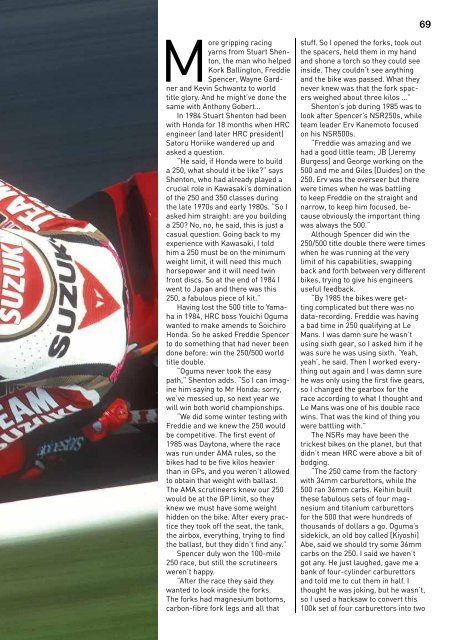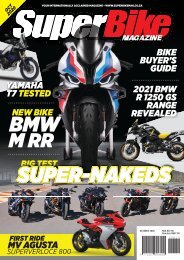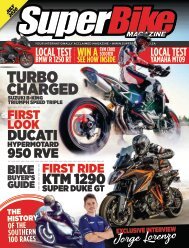SuperBike Magazine September 2020
Loads of content to keep any motorcycle enthusiast entertained!
Loads of content to keep any motorcycle enthusiast entertained!
Create successful ePaper yourself
Turn your PDF publications into a flip-book with our unique Google optimized e-Paper software.
69<br />
More gripping racing<br />
yarns from Stuart Shenton,<br />
the man who helped<br />
Kork Ballington, Freddie<br />
Spencer, Wayne Gardner<br />
and Kevin Schwantz to world<br />
title glory. And he might’ve done the<br />
same with Anthony Gobert…<br />
In 1984 Stuart Shenton had been<br />
with Honda for 18 months when HRC<br />
engineer (and later HRC president)<br />
Satoru Horiike wandered up and<br />
asked a question.<br />
“He said, if Honda were to build<br />
a 250, what should it be like?” says<br />
Shenton, who had already played a<br />
crucial role in Kawasaki’s domination<br />
of the 250 and 350 classes during<br />
the late 1970s and early 1980s. “So I<br />
asked him straight: are you building<br />
a 250? No, no, he said, this is just a<br />
casual question. Going back to my<br />
experience with Kawasaki, I told<br />
him a 250 must be on the minimum<br />
weight limit, it will need this much<br />
horsepower and it will need twin<br />
front discs. So at the end of 1984 I<br />
went to Japan and there was this<br />
250, a fabulous piece of kit.”<br />
Having lost the 500 title to Yamaha<br />
in 1984, HRC boss Youichi Oguma<br />
wanted to make amends to Soichiro<br />
Honda. So he asked Freddie Spencer<br />
to do something that had never been<br />
done before: win the 250/500 world<br />
title double.<br />
“Oguma never took the easy<br />
path,” Shenton adds. “So I can imagine<br />
him saying to Mr Honda: sorry,<br />
we’ve messed up, so next year we<br />
will win both world championships.<br />
“We did some winter testing with<br />
Freddie and we knew the 250 would<br />
be competitive. The first event of<br />
1985 was Daytona, where the race<br />
was run under AMA rules, so the<br />
bikes had to be five kilos heavier<br />
than in GPs, and you weren’t allowed<br />
to obtain that weight with ballast.<br />
The AMA scrutineers knew our 250<br />
would be at the GP limit, so they<br />
knew we must have some weight<br />
hidden on the bike. After every practice<br />
they took off the seat, the tank,<br />
the airbox, everything, trying to find<br />
the ballast, but they didn’t find any.”<br />
Spencer duly won the 100-mile<br />
250 race, but still the scrutineers<br />
weren’t happy.<br />
“After the race they said they<br />
wanted to look inside the forks.<br />
The forks had magnesium bottoms,<br />
carbon-fibre fork legs and all that<br />
stuff. So I opened the forks, took out<br />
the spacers, held them in my hand<br />
and shone a torch so they could see<br />
inside. They couldn’t see anything<br />
and the bike was passed. What they<br />
never knew was that the fork spacers<br />
weighed about three kilos …”<br />
Shenton’s job during 1985 was to<br />
look after Spencer’s NSR250s, while<br />
team leader Erv Kanemoto focused<br />
on his NSR500s.<br />
“Freddie was amazing and we<br />
had a good little team: JB [Jeremy<br />
Burgess] and George working on the<br />
500 and me and Giles [Duides] on the<br />
250. Erv was the overseer but there<br />
were times when he was battling<br />
to keep Freddie on the straight and<br />
narrow, to keep him focused, because<br />
obviously the important thing<br />
was always the 500.”<br />
Although Spencer did win the<br />
250/500 title double there were times<br />
when he was running at the very<br />
limit of his capabilities, swapping<br />
back and forth between very different<br />
bikes, trying to give his engineers<br />
useful feedback.<br />
“By 1985 the bikes were getting<br />
complicated but there was no<br />
data-recording. Freddie was having<br />
a bad time in 250 qualifying at Le<br />
Mans. I was damn sure he wasn’t<br />
using sixth gear, so I asked him if he<br />
was sure he was using sixth. ‘Yeah,<br />
yeah’, he said. Then I worked everything<br />
out again and I was damn sure<br />
he was only using the first five gears,<br />
so I changed the gearbox for the<br />
race according to what I thought and<br />
Le Mans was one of his double race<br />
wins. That was the kind of thing you<br />
were battling with.”<br />
The NSRs may have been the<br />
trickest bikes on the planet, but that<br />
didn’t mean HRC were above a bit of<br />
bodging.<br />
“The 250 came from the factory<br />
with 34mm carburettors, while the<br />
500 ran 36mm carbs. Keihin built<br />
these fabulous sets of four magnesium<br />
and titanium carburettors<br />
for the 500 that were hundreds of<br />
thousands of dollars a go. Oguma’s<br />
sidekick, an old boy called [Kiyoshi]<br />
Abe, said we should try some 36mm<br />
carbs on the 250. I said we haven’t<br />
got any. He just laughed, gave me a<br />
bank of four-cylinder carburettors<br />
and told me to cut them in half. I<br />
thought he was joking, but he wasn’t,<br />
so I used a hacksaw to convert this<br />
100k set of four carburettors into two









